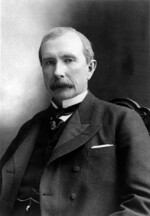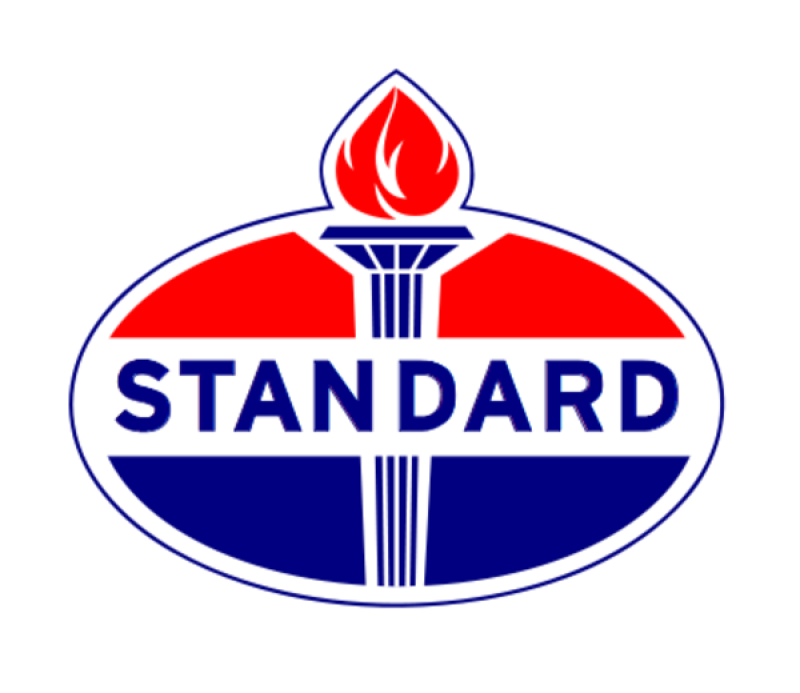Rockefeller and the Rise of Standard Oil
Native Americans and early European explorers knew of oil and natural gas seeps in what became western Pennsylvania and New York well before the middle of the 19th century. However, it wasn’t until Abraham Gesner—the Canadian physician and geologist— discovered how to distill kerosene from crude oil, that interest in the product grew substantially. Petroleum boomed as an industry in the US following the drilling of the country’s first successful well —the Drake Well at Oil Creek, Pennsylvania, in 1859 (Yergin, 2009).
Standard Oil’s pre-history began shortly after the Drake Well, in 1863, when John D. Rockefeller, along with his partners, built an oil refinery near Cleveland, Ohio. The predominant market for refined oil was kerosene used for illumination. Whale oil had become too expensive for most consumers, and a cheaper, general-purpose lighting fuel was in demand. Within 2 years, the refinery that Rockefeller built was the largest in the area, and thereafter he devoted himself exclusively to the oil business.

In 1870, Rockefeller and a few associates, including American financier Henry M. Flagler, incorporated the Standard Oil Company in Ohio. Rockefeller chose the "Standard Oil" moniker as a symbol of the reliable "standards" of quality and service that he envisioned for the nascent oil industry (Yergin, 2009). Standard Oil prospered and began to buy out its competitors rapidly. By 1872, it controlled nearly all the refineries in Cleveland. This provided Standard Oil with significant leverage when negotiating with railroads for favored rates on shipments. It acquired pipelines and terminal facilities, purchased competing refineries in other cities, and vigorously sought to expand its markets in the US and abroad. It kept oil prices low to stave off competitors, made its products affordable to the average household, and to increase market penetration, it sometimes sold below cost. The company also developed more than 300 oil-based products, from tar and paint to petroleum jelly and chewing gum.
With continued expansion, by 1880, Standard Oil refined 90 to 95% of all oil produced in the US. The company's vast American empire included 20,000 domestic wells, 4,000 miles of pipeline, 5,000 tank cars, and more than 100,000 employees (Yergin, 2009).
In 1882, these various companies were combined into the Standard Oil Trust, which would control close to 90 % of the nation's refineries and pipelines. By design, the Standard Oil Trust embraced a maze of legal structures, which made its workings virtually impervious to public investigation and understanding. As journalist Ida Tarbell wrote in her book, The History of the Standard Oil Company (1904), “You could argue its existence from its effects, but you could not prove it.” In 1882, the Ohio Supreme Court ordered the trust dissolved, but it effectively continued to operate from headquarters in New Jersey.
The aggressive market practices of Standard Oil and the growing public hostility toward monopolies—of which Standard was the best-known—prompted some industrialized states to enact antimonopoly laws. At the national level, the Sherman Antitrust Act was the first such law to be passed in 1890.
The Sherman Antitrust Act of 1890
”Trust,” as described in the case of Standard Oil, was commonly used to describe an arrangement where stockholders of several companies turned over their company shares to a single group of individuals called trustees who then administered and controlled the affairs of the newly combined companies. Stockholders received trust certificates entitling them to receive earnings from the trust. Today “monopoly” has replaced “trust” as the word of choice to describe such ventures, but the two are interchangeable.
The Sherman Antitrust Act’s principal author and namesake, John Sherman, was an expert in trade and commerce regulation. He crafted the law to prevent such concentration of power in the hands of a few large players to the disadvantage of smaller enterprises. Specifically, the act sought to prohibit business practices designed to monopolize a market, and forbade anti-competitive agreements that would force small enterprises and new entrants out of a market. The act gave the federal government and the Department of Justice the authority to institute legal suits against enterprises that violated the act.
In Standard Oil Co. of New Jersey v. United States (1911), the Supreme Court unanimously upheld a lower court’s ruling and ruled that the Standard Oil Trust was a monopoly that illegally restrained trade in violation of the Sherman Antitrust Act. The Court ordered the breakup of Standard Oil into smaller companies, some of which are still well known today.
The Modern Legacy of Standard Oil
Standard Oil’s most readily apparent legacy is that many of today’s supermajors have pedigrees stretching back to a company originally born of the breakup of Standard Oil: ExxonMobil, Chevron, BP, and Marathon all descended in some form or fashion from Standard Oil.

However, Standard Oil did more than shape the landscape of the oil and gas industry for more than a century, It introduced a principle by which subsequent antitrust actions have been weighed: the “rule of reason.” This principle holds that business practices are only anticompetitive if they work against the public interest (Yergin, 2009). In layman’s terms, a firm that dominated the market through superior and fair business practices would be allowed to remain large if it continued to operate accordingly. Only those that became large through unfair means were dissolved.
Today, the companies of Big Tech (a nebulous term, but often understood to include Facebook, Apple, Amazon, Microsoft, and Google at the least) face a similar backlash, or colloquially, “techlash” over their various perceived monopolies. However, Big Tech is not a monopoly per se, that is, the companies comprising Big Tech have not agreed to cooperate rather than compete, to their benefit and market detriment. In fact, in recent years they have started attempting to step on each other’s toes in some arenas (e.g., cloud computing services).
The other existing interpretation of the Sherman Act under which they might be dissolved, the “rule of reason” used to measure and divide Standard Oil, has also failed to flag Big Tech as monopolistic, despite clear dominance in various market sectors and some arguably anticompetitive practices (e.g., Facebook’s purchase of Instagram and WhatsApp or the Apple App Store’s requirements and fees). This market dominance was achieved predominately through superior service and/or significant benefits from network effects. And because many of the services are provided to the consumer free in return for the ability to advertise to them and utilize personal data, consumers are not being harmed by artificially inflated prices.
As Lina Khan, chairperson of the Federal Trade Commission, and Jonathan Kanter, assistant attorney general for the Department of Justice’s antitrust division, attempt to take on these corporate behemoths, they face the daunting task of convincing courts to consider alternatives to the century-old “rule of reason.”
There is still plenty of legal drama left to play out before courts reach a decision on the alleged modern-day monopolies. Regulators may craft convincing arguments or find a sympathetic ear in the courtroom using existing legal tools to break up Big Tech under the rule of reason. Alternatively, data, “the new oil,” and the modern-day Standard Oils that peddle it, may require modern-day legal remedies. Possibilities include new interpretations of the Sherman Antitrust Act or altogether new legislation—such as regulating Big Tech as a utility. Finally, although seemingly unlikely given the prevailing public mood, Big Tech may manage to self-regulate, appease both regulators and the public, and escape relatively unscathed.
Thus, even 110 years after its breakup under the even-older Sherman Antitrust Act, Standard Oil has not only shaped the face of the modern-day oil industry but also sculpted the American judicial system’s treatment of antitrust actions. It set the groundwork for today’s showdown against the companies of Big Tech, the resolution of which may have impacts that echo for the next hundred years or more.
References
Yergin, Daniel. The Prize: the Epic Quest for Oil, Money & Power. New York: Free Press, 2009.
[The authors thank Timilehin Adegbamigbe for proofing the article.]

